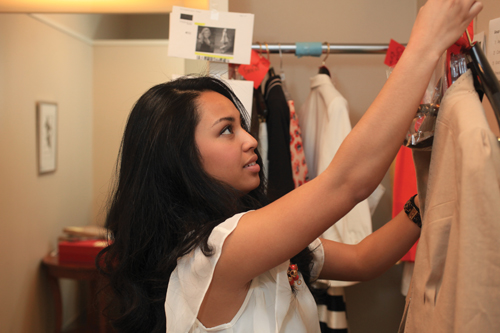Fashion rules
Students get hands-on experience putting together show at Neiman Marcus.

Design, Merchandising and Textiles students worked with upscale retailer Neiman Marcus to put on a fashion show spotlighting hot spring looks and designing store windows focused on the latest trends. (Photos by Carolyn Cruz)
Fashion rules
Students get hands-on experience putting together show at Neiman Marcus.
Shows like “Project Runway” and “America’s Next Top Model” reveal the behind-the-scene work that goes into making fashion appear effortless.
But 36 students who enrolled in one of Merchandising and Textiles Associate Professor Patricia Warrington’s classes got their own hands-on experience, thanks to a unique partnership with Neiman Marcus.
The upscale retailer’s Fort Worth public relations coordinator Aaron Wolfe ’09, contacted the Design, Merchandising and Textiles department late last year about involving students in a fashion show spotlighting hot spring looks and designing store windows focused on the latest trends.
Warrington thought it was a natural fit for students in her Promotion Principles class, which is being renamed Fashion Communications.
“It covers everything from advertising, public relations, direct marketing, social media and visual merchandising,” she said. “It also encompasses window displays as well as on the selling floor; it’s applicable over many types of retail settings.”
The big fashion shows in industry capitals such as New York, Paris and Milan are typically staged by designers targeting retailers to sell their products. In the case of the Neiman Marcus Fort Worth event, the focus was on appealing to consumers looking to incorporate the newest looks into their wardrobes.
“The students learned that while the fashion show may be entertaining, it’s really about selling the merchandise,” Warrington says.
Students had to incorporate top trends for spring as identified by Neiman Marcus Fashion Director Ken Downing into the show, which was staged in March at the Ridgmar Mall store.
“They did story boards and created PowerPoint slides to show their theme for their segment of the show,” Warrington said.
Dividing into teams, students also selected models, pulled merchandise and, on the day of the show, selected accessories. Some teams were charged with creating window displays.
At the last minute, teams had to grapple with issues such as dress and shoe sizes being a bit off, and had to frantically search for replacements just before show time. Warrington said such real-world experience is invaluable.
“We can sit in a fashion show and or we can actually go out there and do it,” Warrington added. “It’s a lot more complicated and doesn’t flow as smoothly as you might think.”
Ryan Murray, a business major, said it was exciting to work on something from beginning to end, even if he didn’t get to see the finished product.
“Unfortunately, I was busy making sure the male models had all the looks on in the right order and was unable to watch most of the show,” he said. “It looked great from what I could see though.”

Your comments are welcome
Comments
Related Reading:
Features
Infographic: Minors
A wide variety of minors gives TCU students the chance to add depth to their majors or dive into new areas.
Features
Venture Capitalism 101
MBA students connect investors and startups in a Neeley program.